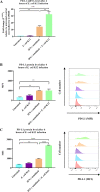Escherichia coli K12 Upregulates Programmed Cell Death Ligand 1 (PD-L1) Expression in Gamma Interferon-Sensitized Intestinal Epithelial Cells via the NF-κB Pathway
- PMID: 33046511
- PMCID: PMC7927934
- DOI: 10.1128/IAI.00618-20
Escherichia coli K12 Upregulates Programmed Cell Death Ligand 1 (PD-L1) Expression in Gamma Interferon-Sensitized Intestinal Epithelial Cells via the NF-κB Pathway
Abstract
Programmed cell death ligand-1 (PD-L1) is an immune checkpoint protein which is used by tumor cells for immune evasion. PD-L1 is upregulated in inflamed intestinal tissues. The intestinal tract is colonized by millions of bacteria, most of which are commensal bacterial species. We hypothesized that under inflammatory conditions, some commensal bacterial species contribute to increased PD-L1 expression in intestinal epithelium and examined this hypothesis. Human intestinal epithelial HT-29 cells with and without interferon (IFN)-γ sensitization were incubated with six strains of four enteric bacterial species. The mRNA and protein levels of PD-L1 in HT-29 cells were examined using quantitative real-time PCR and flow cytometry, respectively. The levels of interleukin (IL)-1β, IL-18, IL-6, IL-8, and tumor necrosis factor (TNF)-α secreted by HT-29 cells were measured using enzyme-linked immunosorbent assay. Apoptosis of HT-29 cells was measured using a caspase 3/7 assay. We found that Escherichia coli K12 significantly upregulated both PD-L1 mRNA and protein in IFN-γ-sensitized HT-29 cells. E. coli K12 induced the production of IL-8 in HT-29 cells, however, IL-8 did not affect HT-29 PD-L1 expression. Inhibition of the nuclear factor-kappa B pathway significantly reduced E. coli K12-induced PD-L1 expression in HT-29 cells. The other two E. coli strains and two enteric bacterial species did not significantly affect PD-L1 expression in HT-29 cells. Enterococcus faecalis significantly inhibited PD-L1 expression due to induction of cell death. Data from this study suggest that some gut bacterial species have the potential to affect immune function under inflammatory conditions via upregulating epithelial PD-L1 expression.
Keywords: E. coli K12; IFN-γ; PD-L1; inflammation; intestinal epithelial cells.
Copyright © 2020 American Society for Microbiology.
Figures






Similar articles
-
Campylobacter concisus upregulates PD-L1 mRNA expression in IFN-γ sensitized intestinal epithelial cells and induces cell death in esophageal epithelial cells.J Oral Microbiol. 2021 Sep 14;13(1):1978732. doi: 10.1080/20002297.2021.1978732. eCollection 2021. J Oral Microbiol. 2021. PMID: 34552702 Free PMC article.
-
Regulation of programmed death ligand 1 expression by interferon-γ and tumour necrosis factor-α in canine tumour cell lines.Vet Comp Oncol. 2023 Jun;21(2):279-290. doi: 10.1111/vco.12886. Epub 2023 Mar 8. Vet Comp Oncol. 2023. PMID: 36802270
-
Inflammatory cytokines IL-17 and TNF-α up-regulate PD-L1 expression in human prostate and colon cancer cells.Immunol Lett. 2017 Apr;184:7-14. doi: 10.1016/j.imlet.2017.02.006. Epub 2017 Feb 14. Immunol Lett. 2017. PMID: 28223102 Free PMC article.
-
Development, validation and implementation of an in vitro model for the study of metabolic and immune function in normal and inflamed human colonic epithelium.Dan Med J. 2015 Jan;62(1):B4973. Dan Med J. 2015. PMID: 25557335 Review.
-
Regulation of PD-L1: a novel role of pro-survival signalling in cancer.Ann Oncol. 2016 Mar;27(3):409-16. doi: 10.1093/annonc/mdv615. Epub 2015 Dec 17. Ann Oncol. 2016. PMID: 26681673 Review.
Cited by
-
Cranberry, but not D-mannose and ibuprofen, prevents against uropathogenic Escherichia coli-induced cell damage and cell death in MDCK cells.Front Microbiol. 2023 Nov 30;14:1319785. doi: 10.3389/fmicb.2023.1319785. eCollection 2023. Front Microbiol. 2023. PMID: 38098676 Free PMC article.
-
Campylobacter concisus upregulates PD-L1 mRNA expression in IFN-γ sensitized intestinal epithelial cells and induces cell death in esophageal epithelial cells.J Oral Microbiol. 2021 Sep 14;13(1):1978732. doi: 10.1080/20002297.2021.1978732. eCollection 2021. J Oral Microbiol. 2021. PMID: 34552702 Free PMC article.
-
Bacterial Lipopolysaccharide Induces PD-L1 Expression and an Invasive Phenotype of Oral Squamous Cell Carcinoma Cells.Cancers (Basel). 2024 Jan 13;16(2):343. doi: 10.3390/cancers16020343. Cancers (Basel). 2024. PMID: 38254832 Free PMC article.
-
Emerging Aeromonas enteric infections: their association with inflammatory bowel disease and novel pathogenic mechanisms.Microbiol Spectr. 2023 Sep 21;11(5):e0108823. doi: 10.1128/spectrum.01088-23. Online ahead of print. Microbiol Spectr. 2023. PMID: 37732778 Free PMC article.
-
Role of PD-L1 in Gut Mucosa Tolerance and Chronic Inflammation.Int J Mol Sci. 2020 Dec 1;21(23):9165. doi: 10.3390/ijms21239165. Int J Mol Sci. 2020. PMID: 33271941 Free PMC article. Review.
References
Publication types
MeSH terms
Substances
LinkOut - more resources
Full Text Sources
Research Materials
Miscellaneous

